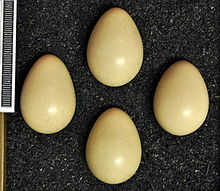Daurian partridge
This article relies largely or entirely on a single source. (September 2017) |
| Daurian partridge | |
|---|---|

| |
| Scientific classification | |
| Domain: | Eukaryota |
| Kingdom: | Animalia |
| Phylum: | Chordata |
| Class: | Aves |
| Order: | Galliformes |
| Family: | Phasianidae |
| Genus: | Perdix |
| Species: | P. dauurica
|
| Binomial name | |
| Perdix dauurica (Pallas, 1811)
| |
The Daurian partridge (Perdix dauurica), also known as steppe partridge, Asian grey partridge or bearded partridge,
Description
It is a rotund bird measuring roughly 28–30 cm (11–12 in) long. In the fall, males weigh about 200–340 grams (7.1–12.0 oz) and 290–330 grams (10–12 oz) for females.[3] Both sexes have a sandy-orange face and long feathers under the beak, forming a 'beard'. The rest of the head and underparts are pale slate-grey with a buff line on the chest and black belly patch. The female has a smaller belly patch and is slightly duller than the male. Their song sounds like a higher-pitched, sped-up version of the grey partridge's; a shrill, grating kieerr-ik![4]
There are multiple subspecies, differing mainly in the plumage becoming darker and more rufous further east.[citation needed]
Distribution and habitat
This

Behaviour
Daurian partridges forage and move most actively during morning/evening hours and rest at mid-day, depending on weather.
Females usually lay around the second to third week of May. The nest is lined with grasses and twigs on the ground under a bush or in tall grass, and the typical clutch size is somewhere around 13–20 olive-brown eggs.[5] Chicks are a pale yellow-brown dappled with shades of dark brown and rufous.[6]
This is a seed-eating species, but the chicks in particular consume insects as an essential protein supply. They are capable of flying short distances around 2 weeks of age. When disturbed, it springs upward with whirring wings in a rapid, explosive manner, then it flies off to nearby cover, all while sounding off an alarmed staccato hek-hek-hek![7]
Subspecies
The daurian partridge has two recognized subspecies:[8]
- P. d. dauurica (Pallas, 1811)
- P. d. suschkini (Poliakov, 1915)
Status
The Daurian partridge is not globally threatened, but may be over-hunted in parts of its range.[citation needed]

References
- .
- ^ "Perdix dauurica (Daurian Partridge) – Avibase". avibase.bsc-eoc.org. Retrieved 7 October 2020.
- ^ "Птицы с "бородками" поселились у южного кордона – Государственный природный биосферный заповедник "Саяно-Шушенский"". sayanzapoved.ru. Retrieved 8 October 2020.
- ^ "Daurian Partridge (Perdix dauurica) :: xeno-canto". xeno-canto.org. Retrieved 26 February 2021.
- ^ "Птицы с "бородками" поселились у южного кордона – Государственный природный биосферный заповедник "Саяно-Шушенский"". sayanzapoved.ru. Retrieved 26 February 2021.
- ^ "Daurian Partridge (Perdix dauurica). Birds of Xinjiang, China". xinjiang.birds.watch. Retrieved 26 February 2021.
- ^ "Daurian Partridge (Perdix dauurica) :: xeno-canto". xeno-canto.org. Retrieved 26 February 2021.
- .
- Pheasants, Partridges and Grouse by Madge and McGowan, ISBN 0-7136-3966-0

